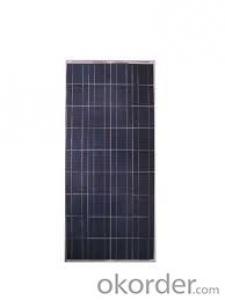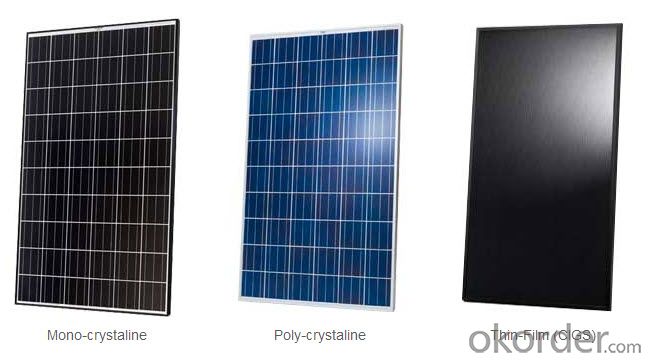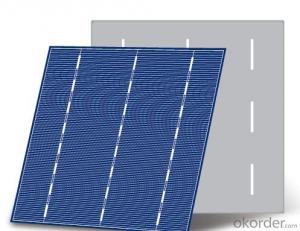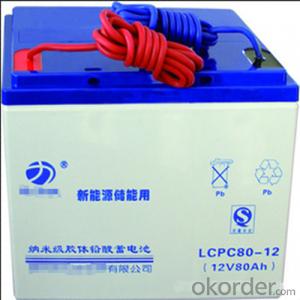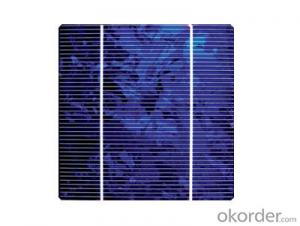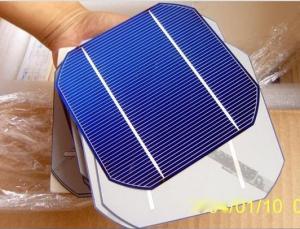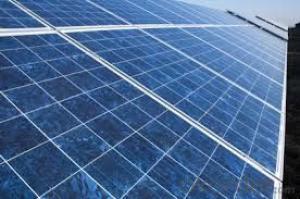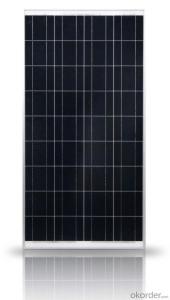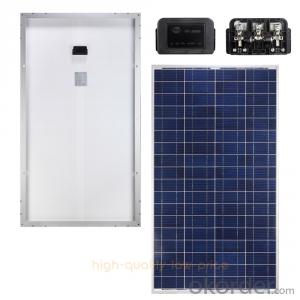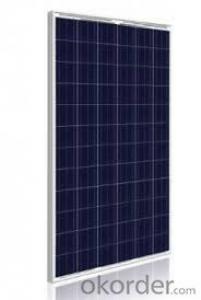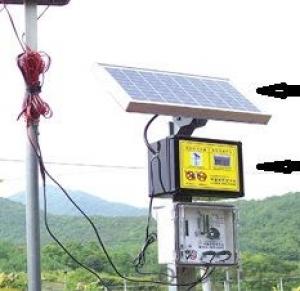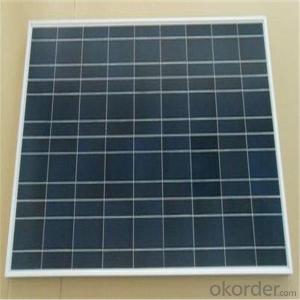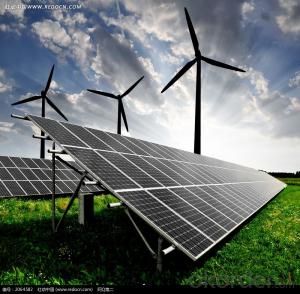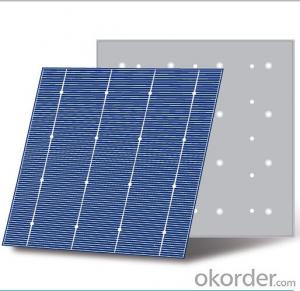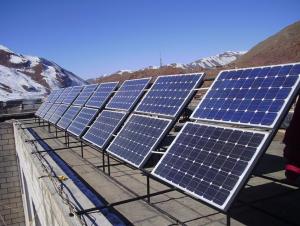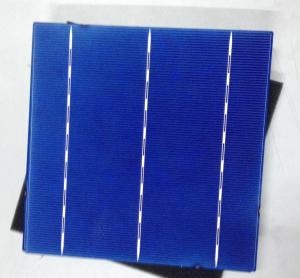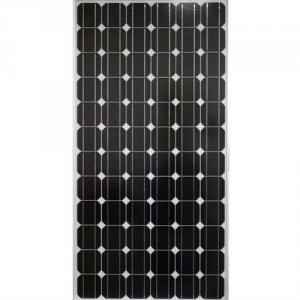Sunpower Solar Cells 235w Poly Solar Panel with 25 Years Warranty CNBM
- Loading Port:
- Qingdao
- Payment Terms:
- TT OR LC
- Min Order Qty:
- 10 set
- Supply Capability:
- 300000 set/month
OKorder Service Pledge
OKorder Financial Service
You Might Also Like
Polycrystalline Solar Modules
CNBM offers a range of small, medium and large polycrystalline solar modules, designed for a range of requirements.
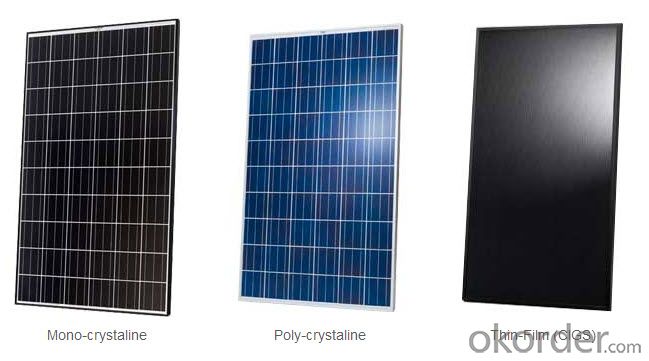
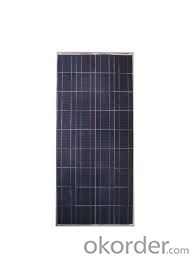
Specifications:
Tolerance | +/-3% |
Cell | Polycrystalline silicon solar cells (156 x 156mm) |
N0. of Cells | 60 (10 x 6) |
Dimension of Modules (mm) | 1650 x 990 x 40 |
Weight (kg) | 25.5 |
Limits:
Operating Temperature | -40~+85? |
Storage Temperature | -40~+85? |
Maximum System Voltage | 1000 VDC max. |
Hail Impact | Diameter of 28mm with impact speed |
Temperature and Coefficients:
NOCT | 48C+/-2? |
Voltage temperature coefficient (%/K) | -0.35 |
Current temperature coefficient (%/K) | 0.05 |
Power temperature coefficient (%/K) | -0.45 |
Characteristics:
Model: | SGM-200P | SGM-210P | SGM-220P |
Max-power voltage Vmp (V) | 29.2 | 29.4 | 29.41 |
Max-power current Imp (A) | 6.85 | 7.14 | 7.48 |
Open-circuit voltage Voc (V) | 36.5 | 36.69 | 36.9 |
Short-Circuit Current Isc (A) | 7.28 | 7.6 | 7.93 |
Max-power Pm(W) | 200 | 210 | 220 |
Model: | SGM-230P |
Max-power voltage Vmp (V) | 29.8 |
Max-power current Imp (A) | 7.72 |
Open-circuit voltage Voc (V) | 37.31 |
Short-Circuit Current Isc (A) | 8.19 |
Max-power Pm(W) | 230 |
STC: Irradiance 1000W/m2, module temperature 25?, AM-=1.5
Poly Crystalline Solar Panels Specifications Range
Maximum Power (Pm) | Dimension | Weight | Operating Voltage (Vmp) | Operating Current (Imp) | Open Circuit Voltage (Voc) | Short Circuit Current (Isc) |
0.45W | 140x80x10mm | 0.08kg | 3.3V | 150mA | 4.6V | 160mA |
1.0W | 162x140x10mm | 0.16kg | 7.5V | 150mA | 10.3V | 160mA |
4.5W | 269x251x23mm | 0.8kg | 16.5V | 0.27A | 20.5V | 0.3A |
10W | 420.1×268.9×22.6mm | 1.92kg | 17.5V | 0.58A | 20.5V | 0.6A |
20W | 425x502x50mm | 3.0kg | 16.8V | 1.19A | 21.0V | 1.29A |
30W | 593x502x22.6mm | 3.9kg | 16.8V | 1.78A | 21.0V | 1.94A |
40W | 655x537x50mm | 5.75kg | 17.3V | 2.31A | 22.1V | 2.54A |
50W | 839x537x50mm | 6.0kg | 17.5V | 2.9A | 21.8V | 3.17A |
65W | 1111x502x50mm | 7.2kg | 17.6V | 3.69A | 22.1V | 3.99A |
80W | 1204x537x50mm | 7.7kg | 17.6V | 4.55A | 22.1V | 4.8A |
- Q: What is the role of combiners in solar cell systems?
- The role of combiners in solar cell systems is to combine the electrical outputs from multiple solar panels into a single circuit, allowing for more efficient utilization of the generated power.
- Q: What is a monocrystalline Silicon Solar Cells?
- A monocrystalline Silicon Solar Cell is a kind of solar cell made of monocrystalline siclicon that has been used for many years. Because it is used in a way that is very unique in their use of a single, very pure crystal of silicon, It is considered to good for longevity.
- Q: Can solar cells be used in areas with high pollution?
- Yes, solar cells can be used in areas with high pollution. However, it is important to note that pollution can have a negative impact on the efficiency and performance of solar cells. Airborne pollutants, such as particulate matter and smog, can reduce the amount of sunlight reaching the cells, thereby decreasing their output. Regular maintenance and cleaning may be required to ensure optimal performance in polluted environments. Additionally, advanced solar cell technologies and designs are being developed to mitigate the effects of pollution and improve their efficiency in such areas.
- Q: What is the role of solar cell inverters in grid-tied systems?
- The role of solar cell inverters in grid-tied systems is to convert the direct current (DC) electricity generated by the solar panels into alternating current (AC) electricity that can be used by the electrical grid. Additionally, they ensure that the solar system operates safely and efficiently by monitoring the grid voltage and frequency, synchronizing with the grid, and providing protection against power fluctuations or interruptions.
- Q: What is the impact of saltwater exposure on solar cell efficiency?
- Saltwater exposure can have a significant negative impact on solar cell efficiency. The saltwater can corrode the metal components of the solar cells, leading to a decrease in their performance and overall efficiency. Additionally, the saltwater can create a conductive pathway that can bypass the solar cells, resulting in a loss of electrical energy. Therefore, it is crucial to protect solar cells from saltwater exposure to maintain their efficiency and prolong their lifespan.
- Q: Can solar cells be used in vehicles?
- Yes, solar cells can be used in vehicles. They are commonly used in electric vehicles (EVs) to charge the battery and provide power to various systems, increasing their range and efficiency. Solar panels can be installed on the roof or hood of a vehicle to capture sunlight and convert it into electricity, helping to reduce reliance on grid charging and decrease carbon emissions.
- Q: Silicon solar cell power generation principle
- Refers to the phenomenon of the object due to the absorption of photons and the phenomenon of electromotive force, when the object is subject to light, the object within the charge distribution state changes in the electromotive force and current generated an effect. Strictly speaking, including two types:
- Q: Can solar cells be used to power remote oil and gas monitoring systems?
- Yes, solar cells can be used to power remote oil and gas monitoring systems. Solar cells convert sunlight into electrical energy, which can be stored in batteries or used directly to power monitoring systems. This renewable energy source provides a reliable and sustainable solution for remote locations where traditional power infrastructure may be unavailable or costly to install.
- Q: How efficient are solar cells?
- Solar cells are highly efficient in converting sunlight into electricity, with the most advanced ones achieving an efficiency of around 20-25%. However, the average efficiency of commercially available solar panels is typically around 15-20%.
- Q: What is the role of charge controllers in solar cell systems?
- The role of charge controllers in solar cell systems is to regulate and optimize the charging process of the batteries connected to the solar panels. They monitor the voltage and current levels from the panels and ensure that the batteries are charged efficiently and safely. Charge controllers also protect the batteries from overcharging, over-discharging, and other potential damage, ultimately extending their lifespan.
Send your message to us
Sunpower Solar Cells 235w Poly Solar Panel with 25 Years Warranty CNBM
- Loading Port:
- Qingdao
- Payment Terms:
- TT OR LC
- Min Order Qty:
- 10 set
- Supply Capability:
- 300000 set/month
OKorder Service Pledge
OKorder Financial Service
Similar products
Hot products
Hot Searches
Related keywords
